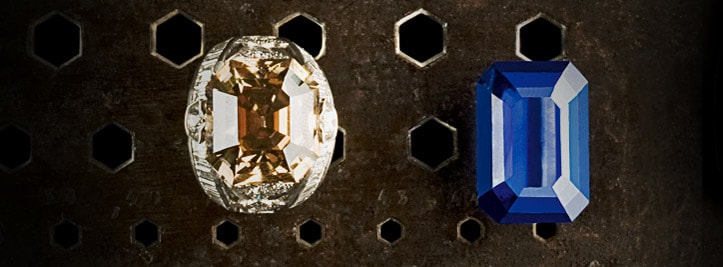COLOURED GEMSTONES

CARTIER’S SOURCING POLICY
Cartier sources its materials with careful, responsible consideration and is committed to continuously improving its ethical, social and environmental performance.
STONE TRANSFORMATION JOURNEY
From its rough state to becoming part of a jewellery creation, traditional and “deep-modifying” treatments can occur that transform a stone:
1. Mineral Growth:
During their growth, minerals are submitted to high temperature & high pressure, and some exogenous chemical elements may integrate & modify the crystal structure
2. Rough treatment:
Traditional practices: heating to modify the colour Vs “deep modifying” treatments such as dyeing or polymer impregnation
3. Cutting & Polishing:
Traditional practices: use of wax during polishing
4. After cut treatment:
Traditional practices: filling of surface reaching inclusions with colourless oil
“Deep-modifying” treatments: coating, dyeing, fracture-filling with lead-glass, heating with diffusion of chemicals…
CARTIER’S COLOURED GEMSTONES TREATMENT POLICY
By enhancing nature’s beauty, Cartier only selects natural gemstones for the Maison's jewellery creations. Synthetic and imitation materials are excluded from the Maison's jewellery collections.
Only traditional practices are accepted for stone treatments in jewellery: these are historically accepted treatments within the stone trade, commonly called “modifications” and most are not considered as treatment by the World Jewellery Confederation.
Cartier prohibits the use of any process altering the composition or the durability of stones. Treatments that will undervalue the stones are not accepted.
FOCUS ON RUBIES, SAPPHIRES AND EMERALDS
Rubies & Sapphires
Stones over 1 carat are exclusively not heated. Heating is accepted for stones below 1 carat only.
Why are rubies and sapphires heated?
Heating is a common procedure to improve colour.
For rubies, heat eliminates blue or brown tints to get an intense red colour. Pale sapphires benefit from heat to boost the hue’s intensity, and dark sapphires lighten when exposed to heat. After heating, the stone colour remains stable.
Emeralds
Cartier only accepts filling with colourless oil. Filling with resin is not accepted.
Oil level is limited to a very small amount compared to the global jewellery market:
▪ maximum "minor" for faceted stones over 1ct
▪ maximum "moderate" for un-faceted stones (cabochons, beads and engraved stones)
Why do emeralds need oiling?
Emerald is a stone with natural inclusions. Filling the surface reaching inclusions with oil enables the improvement of the stone’s transparency. Emerald oiling, a lapidary process recorded in ancient times, has been practiced ever since. Oiling is a reversible procedure that does not harm or modify the stone. The stones with the lowest fill level are more highly valued.
STONE TREATMENTS AND SCIENTIFIC EVOLUTION
Treatment techniques and the ability to detect them evolve over time. Cartier stones are analysed by recognised laboratories, and their conclusions are given in accordance with current scientific knowledge.